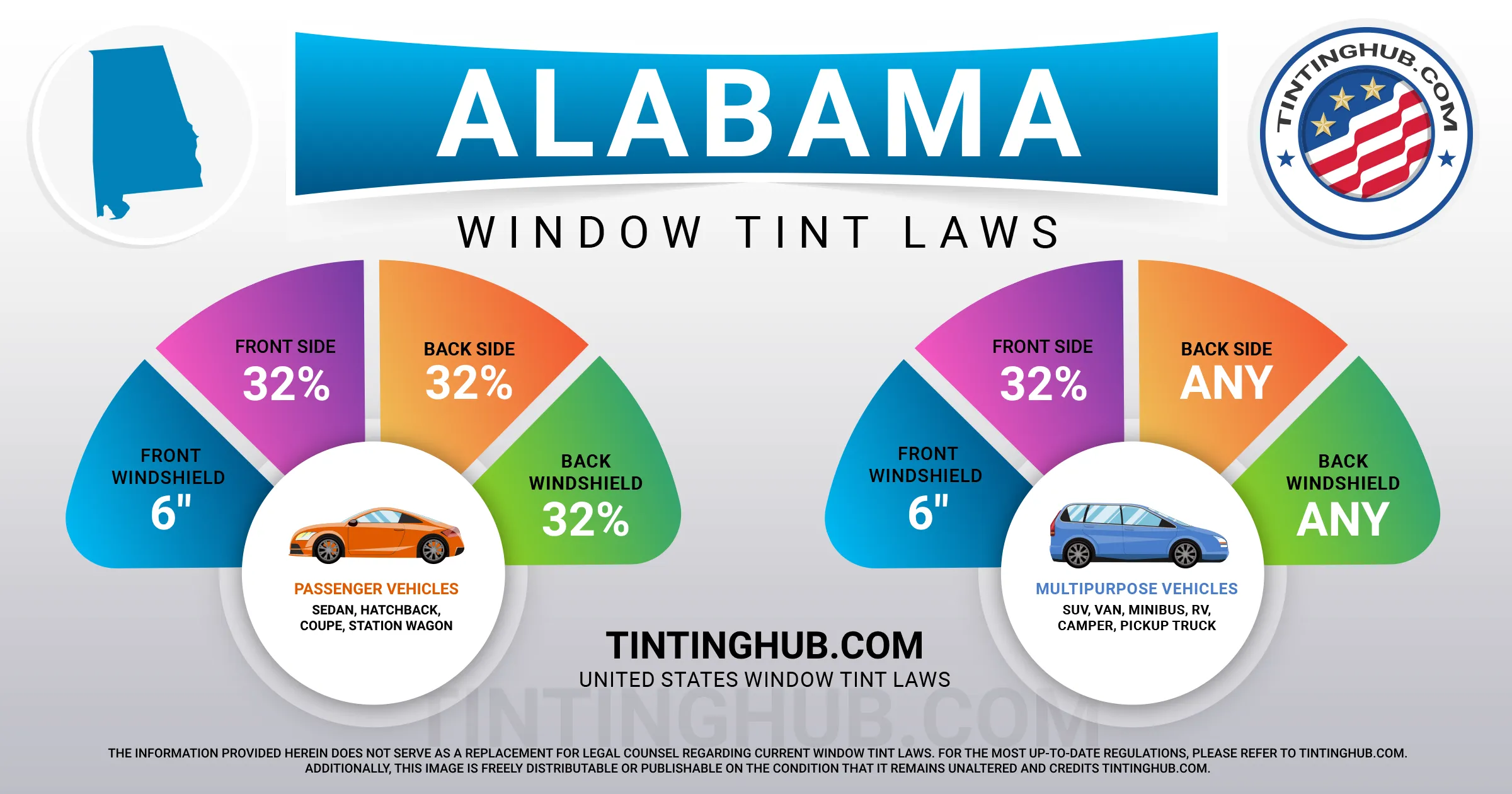Alabama Window Tint Laws (Last Update 2024)

Car window tinting laws in Alabama have been in place since 1996, governing the darkness and reflectivity of window tints. In this article, we will provide you with detailed information about these laws and regulations, ensuring you’re well-informed about what’s allowed in the state.

Understanding Window Tint Darkness (VLT) in Alabama
We measure window tint darkness as a percentage of visible light transmission (VLT) that the tint allows through your car’s windows. Alabama has distinct VLT percentages for sedan cars and SUVs/vans.
Tint Darkness for Sedans
For sedan vehicles, the regulations are as follows:
- Windshield: Non-reflective tint is allowed on the top 6 inches of the windshield.
- Front Side Windows: Must allow more than 32% of light in.
- Back Side Windows: Must allow more than 32% of light in.
- Rear Window: Must allow more than 32% of light in.
Tint Darkness for SUVs and Vans
If you drive an SUV or van, the tint darkness rules are slightly different:
- Windshield: Non-reflective tint is allowed on the top 6 inches of the windshield.
- Front Side Windows: Must allow more than 32% of light in.
- Back Side Windows: Any level of darkness can be used.
- Rear Window: Any level of darkness can be used.
Understanding Window Tint Reflection in Alabama
Window tint can reflect incoming light, reducing glare and heat within the vehicle. Alabama law stipulates the maximum allowable window tint reflection percentages.
Tint Reflection for Sedans
For sedan vehicles, the rules are as follows:
- Front Side Windows: Must not be more than 20% reflective.
- Back Side Windows: Must not be more than 20% reflective.
Tint Reflection for SUVs and Vans
If you drive an SUV or van, the reflection regulations are identical:
- Front Side Windows: Must not be more than 20% reflective.
- Back Side Windows: Must not be more than 20% reflective.
Additional Alabama Window Tint Rules and Regulations
Alabama’s window tinting regulations encompass a few more critical aspects, including:
- Side Mirrors: There are no specific restrictions regarding side mirrors.
- Tint Colors: Alabama permits all tint colors; there are no color restrictions.
- Certificates: Manufacturers of window film must certify the film they sell in the state. Always inquire if your dealer is using certified film.
- Stickers: A sticker or label indicating compliance with legal tinting regulations is required between the film and glass on each tinted window.
- Medical Exceptions: Alabama allows medical exemptions for special tint. For detailed information about the specific terms of this exemption, consult Alabama state law.
- Penalties: Violating tinting regulations can result in penalties. For the first conviction, you may face a maximum fine of $100 and/or up to 10 days in prison. A second conviction within a year can lead to a maximum fine of $200 and/or up to 30 days in jail. Third and subsequent offenses within a year may result in a maximum fine of $500 and/or up to 3 months in prison.
Please note that county or place of residence may vary in interpreting Alabama’s tinting laws and regulations. We always recommend that you double-check the information with your local DMV or law enforcement authorities to ensure compliance.
We last updated our information about Alabama’s window tint laws in 2024. If you find any discrepancies or need updates, please feel free to contact us. We are committed to providing accurate and up-to-date information on window tint laws in Alabama.
As a trusted industry leader, we take pride in offering reliable guidance on window tint laws and regulations. Stay informed and drive legally with the right window tint for your vehicle.
Comprehensive List of Cities and Counties in Alabama
Alabama, nestled in the southeastern United States, boasts diverse borders, with Tennessee to the north, Georgia to the east, Florida and the Gulf of Mexico to the south, and Mississippi to the west.
Ranked as the 30th largest state and the home to the 23rd largest population among the 50 states, Alabama spans 52,419 square miles (135,765 km2). Notably, it features an impressive 1,300 miles (2,100 km) of navigable inland waterways.
Key Facts:
- Capital: Montgomery
- Population: 5,039,877
Notable Cities: Birmingham, Mobile, Huntsville, Montgomery, Tuscaloosa, Auburn, Gulf Shores, Dothan, Gadsden, Orange Beach, Anniston, Decatur, Muscle Shoals, Florence, Hoover, Fairhope, Cullman, Bessemer, Talladega, Dauphin Island, Nectar, Daphne, Selma, Madison, Prattville, Arab, Opelika, Foley, Dora, Eufaula, Tuskegee, Enterprise, Athens, Alabaster, Scottsboro, Troy, Guntersville, Montevallo, Jasper, Andalusia, Columbiana, Wetumpka, Mentone, Phenix City, Vestavia Hills, Mountain Brook, Trussville, Riderville, Oxford.
Diverse Counties: Autauga, Baldwin, Barbour, Bibb, Blount, Bullock, Butler, Calhoun, Chambers, Cherokee, Chilton, Chocktaw, Clarke, Clay, Cleburne, Coffee, Colbert, Conecuh, Coosa, Covington, Crenshaw, Cullman, Dale, Dallas, DeKalb, Elmore, Escambia, Etowah, Fayette, Franklin, Geneva, Greene, Hale, Henry, Houston, Jackson, Jefferson, Lamar, Lauderdale, Lawrence, Lee, Limestone, Lowndes, Macon, Madison, Marengo, Marion, Marshall, Mobile, Monroe, Montgomery, Morgan, Perry, Pickens, Pike, Randolph, Russell, Shelby, St. Clair, Sumter, Talladega, Tallapoosa, Tuscaloosa, Walker, Washington, Wilcox, Winston.